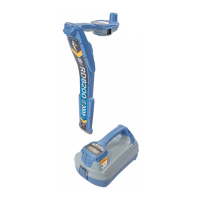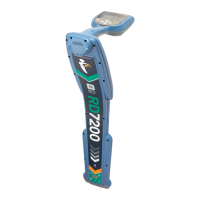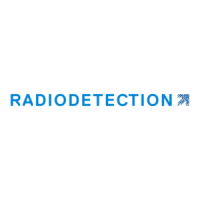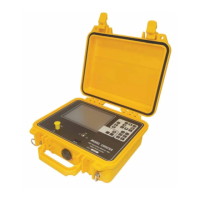© 2020 Radiodetection Ltd 47
13.6 Sondes
Sonde overview
A sonde is a self-contained battery operated transmitter
used for tracing the paths of pipes, ducts, sewers and
drains and in the precise location of blockages or
collapses. The sonde can be fitted to a flexible rod for
insertion or pushing through pipes etc. and the smaller
diameter sondes can be used in conjunction with jetting
machines and blown through the duct. A suitable
Radiodetection locator can then be used to locate the
sonde
Choosing a suitable sonde
Radiodetection offers a wide range of sonde to suit most
applications: From the ¼” / 6 mm diameter S6 33kHz
microsonde which, with a range of 6.6” / 2m, targets
fiber-optic micro ducting or other small non-conductive
pipes, to the 33kHz Super Sonde, which with a depth
range of 50 feet / 15m targets deep sewer pipes.
Consult the precision locate accessory range brochure
or web page on www.radiodetection.com for a full list of
all available sondes and their technical specifications.
Check that the sonde has sufficient range for the
application and is dimensionally small enough and
sufficiently robust for the application. Ensure that the
frequency of the sonde corresponds with the locator
frequency; the locator will not locate the sonde unless
the frequencies are the same. Sondes are marked with
their transmitting frequency. Ensure that the means of
propelling the sonde is available together with the
correct fittings and couplings.
Preparation
Insert a new battery into the sonde. A new battery or a
freshly recharged battery should be used at the
beginning of each day and preferably at the start of each
new job.
Before inserting the sonde, check that the sonde and
locator are at the same frequency and working correctly.
To do this, place the sonde on the ground at a distance
from the locator that is equal to the rated depth of the
sonde. Point the locator at the sonde with the antenna in
line with the sonde (the opposite of using the locator to
locate a line) and check that the bargraph reading
exceeds 50% at maximum sensitivity.
Propelling a sonde
Sondes have a thread at one end for connecting to drain
rods, or to other devices for inserting and propelling the
sonde along a drain or duct. Sondes may be floated
along drains at the end of a tether and floats are
available for fitting to the sewer sonde and super sonde.
Sondes can be strapped to high-pressure water jets or
similar devices used for cleaning, maintaining and
inspecting drains. Sondes used in underground drilling
and boring operations are normally housed in the boring
or drill head behind the boring or drill bit.
Locating and tracing a sonde
Insert the sonde in the drain or duct access and locate it
while it is still just in view at the drain or duct entrance.
Hold the locator vertical directly over the sonde with the
antenna in line with the sonde. Adjust the locator
sensitivity so the bar graph reads between 60% and
80%.
The sonde radiates a Peak field from the center of its
axis with a ghost signal at each end of the Peak. Move
the locator a little way behind and then in front of the axis
of the sonde to detect the ghost signals. Finding the two
ghost signals positively confirms the locate. Reduce the
locator sensitivity to lose the ghost signals but still
indicate a clear Peak response directly over the sonde.
Locator sensitivity is now set for tracing the duct or drain
unless the distance between sonde and locator
changes.
Propel the sonde three paces along the drain or duct and
stop. Place the locator over the supposed position of the
sonde. Do not adjust the sensitivity level.
Figure 13.10 Sonde deployment
To locate a sonde:
1 Move the locator backwards and forwards and stop
when the bar graph indicates a Peak. You can use
the LCD compass to orient the blade of the locator
with the direction of the sonde.
2 Rotate the locator as if the blade is a pivot. Stop
when the bar graph indicates a Peak.
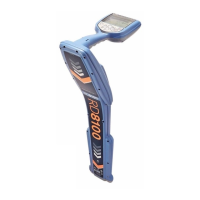
